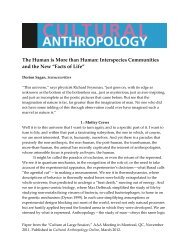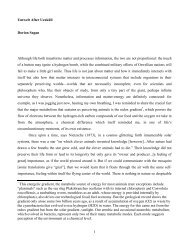PESTICIDES IN COCA-COLA AND PEPSI - Cultural Anthropology
PESTICIDES IN COCA-COLA AND PEPSI - Cultural Anthropology
PESTICIDES IN COCA-COLA AND PEPSI - Cultural Anthropology
Create successful ePaper yourself
Turn your PDF publications into a flip-book with our unique Google optimized e-Paper software.
CULTURAL ANTHROPOLOGY 22:4<br />
676<br />
breaking bottles of Coca-Cola and Pepsi are efforts aimed at countercolonization,<br />
using the cultural idiom of dishonor and rejection, of discursive space, which is<br />
otherwise dominated by technoeconomic debates about pesticides, contamination,<br />
and foreign investment.<br />
The media coverage of the pesticides controversy also reveals the shifting<br />
middle-class expectations of the state. The globalization-fueled trajectories of development<br />
ascendant in many developing countries have in most cases exacerbated<br />
the existing socioeconomic differences, with one of the outcomes being an intensified<br />
demand for services traditionally provided by the state. The welfare state, in its<br />
attenuated form has turned into a mere shadow of itself and is unwilling or unable<br />
to fulfill its side of the social compact. Thus, there is a move toward privatization<br />
of security, law enforcement, and provision of basic amenities, such as drinking<br />
water and electricity. Cities like Mumbai and Delhi have seen gated communities<br />
sprout, aimed ostensibly at affording their better-off residents higher levels of security<br />
than what the state is able to provide. Economic changes beginning in the 1990s<br />
in India ushered sections of its society into a postindustrial bubble, surrounded<br />
by vast numbers of people living in industrial or even preindustrial conditions. A<br />
peculiar combination of physical proximity and social distance is starting to emerge<br />
in cities in developing countries, with the underlying social alienation leading to<br />
the emergence of gated communities. The socioeconomic power differences, once<br />
sedimented in caste-based segregated settlements, are now being reinscribed in<br />
gated communities (Waldrop 2004).<br />
It would therefore be partial and misleading to ascribe only inclusivity to the<br />
practice of consumerism. Equally likely is the possibility of consumer choice being<br />
expressed through esoteric and elitist lifestyle statements, aimed at constructing a<br />
hierarchy of taste, instead of being exercised in the service of mitigating entrenched<br />
structural constraints. A similar point is made when, following Bourdieu, Miller<br />
challenges the liberatory premise of Fair Trade by noting that “purchase of exotic<br />
foods from different parts of the world is a better sign of new strategies of social exclusion<br />
than any evidence of empathetic social inclusion” (2001:118). Shoppers may<br />
become “educated” and even adept in deploying up-to-date rhetoric, but practice<br />
may remain largely unaffected, a phenomenon much in evidence, as the rampant<br />
discrepancies between the discourse and the practice of environmentalism show.<br />
Miller terms the equation of green values and practices to a mere choice of lifestyle<br />
as the manifestation of “objectification of ethical consumption as a ‘sub-cultural’<br />
lifestyle” (2001:129).






